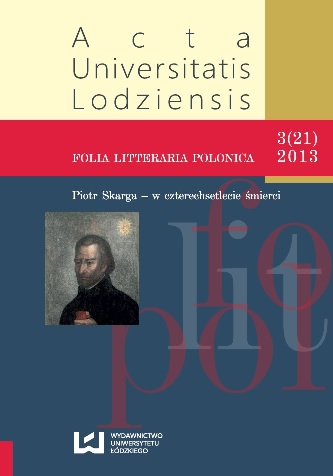Recepcja Skargowskiej metody parenetycznej w polskim żywotopisarstwie XIX wieku Prokop Leszczyński OFMCap (1812–1895) i ultramontańskie źródła „rene
Reception of Skarga’s Parenetic Method in Polish Hagiography of Nineteenth Century Prokop Leszczyński OFMCap (1812–1895) and Ultramontanistic Sources
Author(s): Anna KapuścińskaSubject(s): Literary Texts
Published by: Wydawnictwo Uniwersytetu Łódzkiego
Keywords: Piotr Skarga; Prokop Leszczynski; posttridentine hagiography; capuchins hagiography; ultramontanism
Summary/Abstract: In considering the problem of ultramontanistic sources of the rising of post-tridentine hagiography we should point out understatements or ambiguities on some questions that have been almost beyond the scope of research interest: first of all on reception of Skarga’s hagiographical model in Polish parenetic tradition; furthermore, on its importance and, more broadly, importance of widely understood hagiographical literature in the nineteenth century as a time of constant struggle for religion and national identity of the Poles; finally, on the timeliness of Skarga’s hagiographical model as well as his parenetic project in nineteenth-century ultramontanistic pastoral conceptions and practice, in particular in the works of the Polish Capuchin Prokop Leszczyński. This article discusses the most important moments in constructing the ultramontanistic view of hagiography and the role of Skarga’s Żywoty Świętych Starego i Nowego Zakonu (1579) in developing of the religious and social action connected with rechristianisation of the Poles and raising their denotative awareness. In this context, it shows the views of, inter alia, Adam Mickiewicz, Bogdan Jański, Hieronim Kajsiewicz who prepared intellectual background for messianistic and ultra-montanistic attitudes towards regeneration of Polish society. When looking at publishing and writing practice in the second half of the nineteenth century, one should recognize their influence and regard the hagiographical discourse as having a really formative effect on Polish religious and national consciousness. In an abundant parenetic production there was a strong identification between sanctity, understood as heroic Catholicism, and love of the motherland. The scope of this production included popular, devotional collections of lives of the Polish saints which had been subordinated to the moral and patriotic idea, moreover, weakly associated with the post-tridentine, Skargian model. Opposite of them was the work Żywoty Świętych Pańskich by Leszczyński (1874), retaining popularity for over twenty five years, that articulated and promoted universal Christian ideas of social and personal morality, spirituality, charity, loyalty, integrity, as well as fidelity to the Roman Church and Catholic Orthodoxy. The analysis shows that the text draws clear inspiration from the work of the sixteenth-century Jesuit, however it appears still original and formative by adapting Skarga’s hagiographic model to the needs and religious programme of ultramontanistic pastoral work, as well as because of its transnational character, derived from the extranational character of its sources.
Journal: Acta Universitatis Lodziensis. Folia Litteraria Polonica
- Issue Year: 21/2013
- Issue No: 3
- Page Range: 317-344
- Page Count: 28
- Language: Polish

